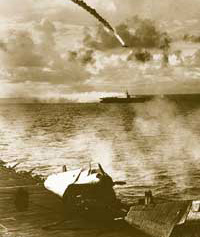The War in the Pacific

World War II in the Pacific was characterized by large-scale naval and air battles. Here, a Japanese plane plunges in flames during an attack on a U.S. carrier fleet in the Mariana Islands, June 1944. U.S. Army and Marine forces' "island hopping" campaign began at Guadalcanal in August 1942 and ended with the assault on Okinawa in April 1945.
(The National Archives)
U.S. troops were forced to surrender in the Philippines in early 1942, but the Americans rallied in the following months. General James "Jimmy" Doolittle led U.S. Army bombers on a raid over Tokyo in April; it had little actual military significance, but gave Americans an immense psychological boost.
In May, at the Battle of the Coral Sea -- the first naval engagement in history in which all the fighting was done by carrier-based planes -- a Japanese naval invasion fleet sent to strike at southern New Guinea and Australia was turned back by a U.S. task force in a close battle. A few weeks later, the naval Battle of Midway in the central Pacific resulted in the first major defeat of the Japanese Navy, which lost four aircraft carriers. Ending the Japanese advance across the central Pacific, Midway was the turning point.
Other battles also contributed to Allied success. The six-month land and sea battle for the island of Guadalcanal (August 1942-February 1943) was the first major U.S. ground victory in the Pacific. For most of the next two years, American and Australian troops fought their way northward from the South Pacific and westward from the Central Pacific, capturing the Solomons, the Gilberts, the Marshalls, and the Marianas in a series of amphibious assaults.
